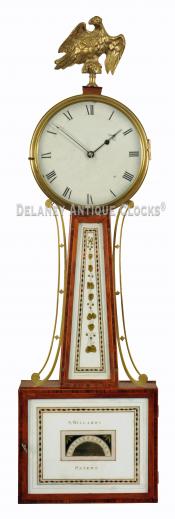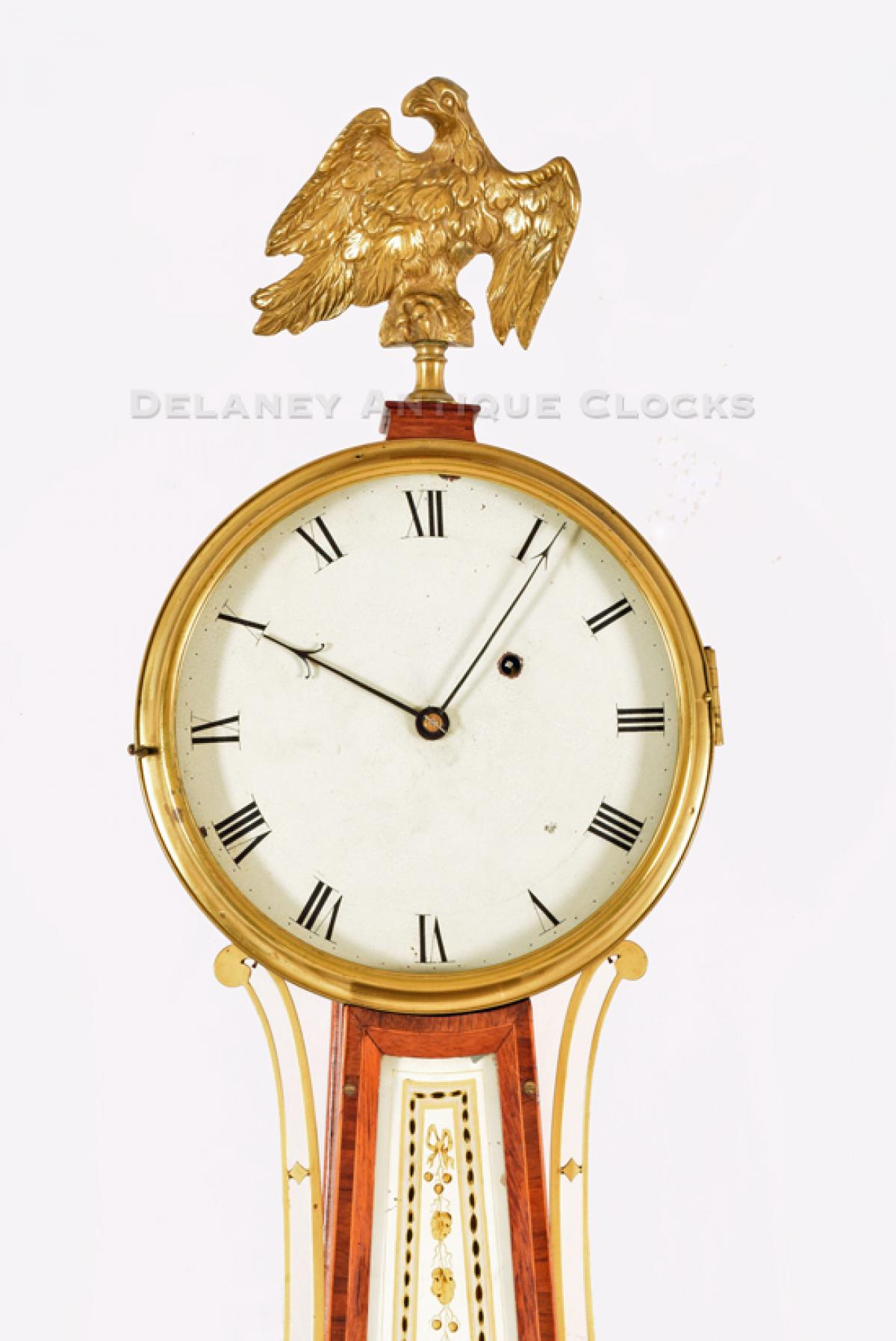Simon Willard's Patent Timepiece. A wall clock commonly called a "Banjo clock." XXSL-2.
Simon Willard timepiece. It is this very form that Simon Willard famously patented in 1802. This U.S. Patent provided Simon with fourteen years to produce this form exclusively. President Thomas Jefferson signed this document. Simon's wall-hanging timepiece was a revolutionary design. This clock is compact, reliable, and an accurate eight-day timekeeper.
This clock case is constructed in mahogany and exhibits excellent early proportions. Characteristics one likes to find in the construction of these cases are exhibited in the following details. This case features the compressed finial plinth, the uniform cut-out head, identifiable glue-blocking placement in the interior of the lower box, extension blocking for the door hinges, splined joinery in the corners of the frames, and a rabbited throat frame to fit onto the throat section. The flat frames are cross-banded with rosewood veneer. This detail is bordered with a light line inlay on both sides. The throat frame is secured to the case with four screws. Brass side arms flank the throat section of the case. They are lightly formed and pinned to the case in three locations. The center pinning is through the center diamond. The Eagle form finial and bezel are also cast in brass. The bezel is fitted with a convex piece of glass and opens to access the painted iron dial.
The enameled dial features an open time track that incorporates Roman-style hour numerals. The hour and minute hands are made of steel. They are expertly hand-filed and have been blued.
Both of the cross-banded frames are fitted with paint-decorated glass tablets. The white field suspends a number of gilt designs and or patterns. These designs are executed with an expert hand. The lower tablet is signed by the Maker, 'S. Willard's Patent.' Both tablets are original to this clock and are in excellent condition.
The time-only weight-driven movement is an eight-day brass construction design. It features large brass plates and step train gearing. The teeth in the gear train are deeply cut. The pendulum is supported by a T-bridge suspension. The movement is mounted to the back of the case with the original through bolts.
The cast brass eagle finial surmounts the case and is mounted on a mahogany chimney plinth.
This is a very attractive Federal Massachusetts Timepiece or 'Banjo clock' that was made circa 1807. This clock measures approximately 34.25 inches long.
Inventory number XXSL2.
Simon Willard was born in Grafton, Massachusetts, on April 3, 1753. He was the seventh of twelve children born to Benjamin Willard (1716-1775) and Sarah (Brooks) Willard (1717-1775) of Grafton. While living in Grafton, Simon answered the Lexington alarm on April 19, 1775, along with his brothers. It is thought that by 1782 he moved from Grafton and took up residence in Roxbury as a Clockmaker. Simon became a Master Clockmaker as well as an inventor. He is well known for receiving patents for his roasting jack in 1782, his "Improved Timepiece" or Banjo clock in 1802, and an alarm clock patent. In addition, he trained many men to make clocks who became well-known Clockmakers once their apprenticeships were served. Some of them include the brothers Levi and Able Hutchins, Elnathan Taber, William Cummens, Ezekiel Jones and Daniel Munroe. Some of the more notable public clocks Simon built include the clock in the United States Capitol building's Statuary Hall. He also built a clock for the House of Representatives and the U. S. Senate. Simon died on August 30, 1848, at the age of 95.














